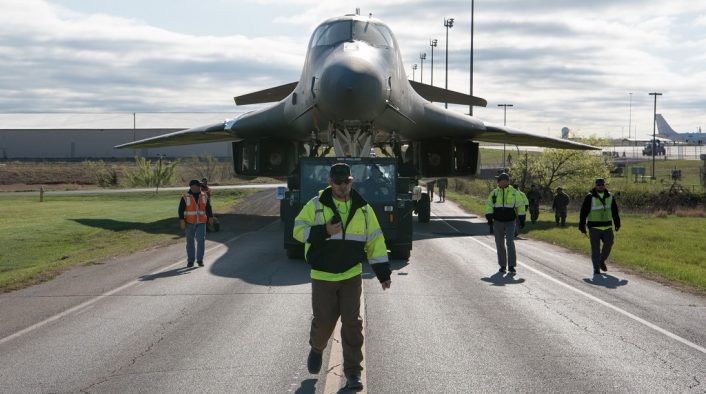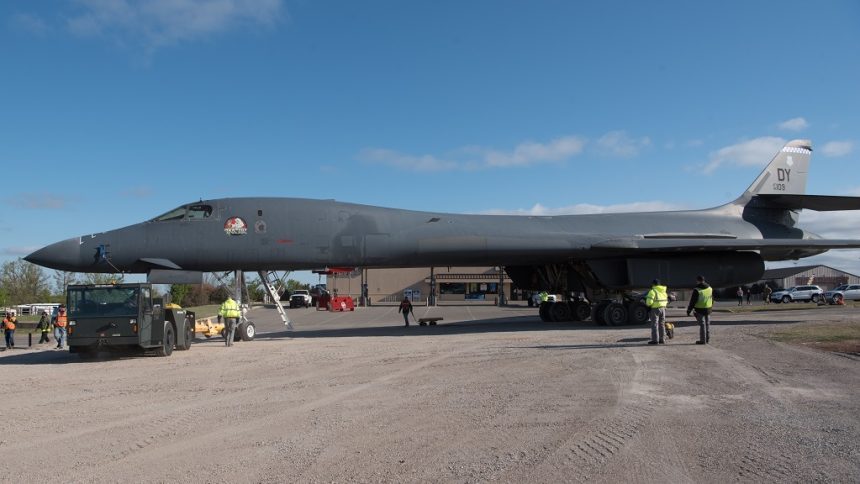Infamous B-1B “Spectre” Retired To Become An Advanced Maintenance Trainer at Tinker Air Force Base.
The U.S. Air Force disclosed a few days ago that, in early April, the B-1B Lancer 86-109/DY, nicknamed “Spectre”, has been retired at Tinker Air Force Base to become an advanced maintenance trainer. The aircraft was towed to an Aircraft Battle Damage Repair training pad at the 76th Maintenance Group’s Expeditionary Depot Maintenance Flight on the south side of the base, where it joined a B-52 Stratofortress and a C-135 Stratolifter.
The same “Bone” (as the B-1 is nicknamed in the pilot community) was involved in a May 2018 inflight emergency while it was returning to Dyess Air Force Base (Texas) after a routine training sortie. Multiple fire warnings lighted in the cockpit as the engine number three caught fire and reportedly spread to another engine. All but one fire were extinguished and, following the emergency checklist’s procedures, the crew initiated the ejection sequence.
However, when the Offensive Systems Operator’s ejection seat failed to leave the plane successfully, the aircraft commander ordered the crew to immediately stop the escape procedure and diverted to Midland International Air and Space Port near Odessa, Texas, still on fire with a missing hatch, no cockpit pressurization and an armed ejection seat that could fire at any moment, performing a successful emergency landing without injury or further damage to the aircraft. The four crew members have been later awarded the Air Force’s Distinguished Flying Cross.
At the end of October 2018, the damaged B-1B was flown to Tinker A.F.B. by an Air Force Reserve crew from the 10th Flight Test Squadron. The crew had to fly the “Bone” on just three engines without raising the landing gear and without sweeping the wings for the entirety of the flight. At that time, the press release said that “Spectre” was to “undergo depot maintenance and upgrades at the Oklahoma City Air Logistics Complex, be quality tested by the 10th FLTS, and be returned to the Dyess AFB B-1B Lancer fleet upon completion”.

It seems however that there was a change of plans, as the aircraft was included in the 17 B-1Bs with the least amount of usable life that have been marked for early retirement to allow the Air Force to prioritize the health of the fleet. These bombers had experienced significant structural fatigue, with cracks appearing in highly stressed structural components joining the wings to the fuselage, which would have required each ten to thirty million dollars for the repairs.
“The artisans of the Oklahoma City Air Logistics Complex repaired the damaged nacelle, replaced the ejection system, and performed both the Integrated Battle Station modification and a full Programmed Depot Maintenance overhaul,” said Col. Greg Lowe, 76th Aircraft Maintenance Group commander. “Despite all of the work, the aircraft was selected for retirement, but it will be a welcome addition to the ABDR [Aircraft Battle Damage Repair] program.”
So, after 12,136 flying hours and almost three years after that inflight emergency, “Spectre” left the flight line for the last time following its divesture which saw the removal of its engines, certain avionics and other equipment not essential for its new mission. According to the press release, for the aircraft to safely leave the flight line and travel to its new home, two temporary gravel ramps were constructed. A number of road signs, poles and a power line had to be temporarily removed to give the aircraft an unobstructed path.
The bomber’s wings were kept in their swept position to keep the aircraft’s footprint as narrow as possible, with two counterweights, each weighing 2,640 pounds, suspended from the forward section of the aircraft to preserve the balance as it was towed. Following the 20 minutes-long half-mile trip, the wings “were manually brought forward one at a time using only a cordless drill, which took about 5 minutes per wing”, instead of the usual 10 seconds when done in flight.
Even if now retired, “Spectre” will still perform, within the Expeditionary Depot Maintenance Flight, an important mission that will be advantage of the entire B-1B fleet. “This aircraft will be important to train for advanced repair techniques and as an engineering test aid for form, fit, and function of future modifications and structural repairs,” said Col. Lowe.
As mentioned in the press release, the Expeditionary Depot Maintenance flight is responsible for maintaining the Air Force’s sole source for ABDR rapid repair capabilities for the entire tanker and bomber fleets, which are tested and trained on its B-52 and C-135 maintenance trainers and, from now on, also on the B-1.









